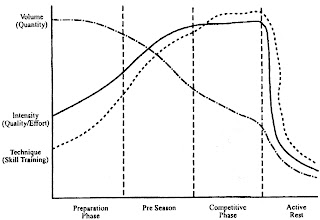Welcome to the first of a series of articles pertaining to
the appropriate periodization of a trampoline athlete. There are many ways to
periodize an athlete’s training program which is all dependant on their
individual sport, the level of the athlete and of course the specific
characteristics of the athlete themselves. Each article of this series will discuss a
particular phase of the periodization and list a sample program for an athlete
of different levels. To save time I will only write a program each week for a Provincial
level 1-4 and a Senior team member.
First let us define periodization. This is the concept of systematically
cycling different aspects of training to develop an athlete for competition. Eastern block Countries were the first known
users of periodization and after the 1960’s the concept migrated to the rest of
the world. Periodization is intended for a four year Olympic cycle but has now
been passed down to the majority of athletes for use. In the Case of a
trampolinist we cannot look at a traditional case of periodization because our
sport does not allow for it. Well, you can do a traditional style but most likely
you will not get the same results. So what is a traditional style of
periodization? It is the concept of going through a number of different phases
in a yearlong training program and repeating these phases periodically. Anyone that has done a wide range of sports
understands that many sports allow for a significant time off, sometimes
lasting a few months that consists of no training at all. Sports such as hockey
and basketball do not have very long competition seasons and a lot of their preparation
for games is done before the season even begins. Anyone who has done trampoline
knows that if you are a senior team member you are not entitled to this grace
period to allow the body to rest and rejuvenate. Our competitions basically go
year round. Unlike a hockey player for instance we do not get an entire summer
off before a gradual training stimulus is reset for the following year. Worlds
is held in November and first qualification is usually sometime in January.
This gives the athlete around 1-2 months to be ready to compete a high
difficulty for the following year. I wonder who devised this competition
schedule. So this leaves a trampolinist
with no real “off-season” and traditional periodization is based on the fact
that you do not compete year round, so let’s find another method.
Linear Periodization
Figure 1: This is the traditional model of periodization.
You can see the inverse relationship of volume to intensity which I will talk
about later in the series.
A trampolinist needs to be in top shape almost all year
long. This of course cannot be the case, at least for most of us. This is why
the first few qualifiers tend to be very sloppy at least for the seniors. A
provincial athlete does have a long off period because while the seniors are
constantly doing routines in preparation for worlds, provincial athletes have
an entire summer and fall off with an invitational here or there. Some ask, “why
don’t they just put all the world cups in a month or two and get it over with
in August?” Well one reason could be because the few athletes that have to go
to all of the world cups will not get any time at home for a life outside of
the sport. In the case of let’s say baseball or hockey the teams generally stay
within North America and find it easier to travel. Most world cups are in Asia or
Europe and this can be quite a hassle for the athletes of Canada and the USA if
they were to have 4 world cups in a space of 2 months. So how can a trampolinist stay in tip top
shape 90% of the year and still achieve results? It is a periodization plan
that is not very common that comes to the rescue. This periodization plan
requires the athlete to be at peak mental state within a month in between
competitions and sometimes a week.
The general idea is that a senior trampolinist goes through
every cycle of the year long periodization, every week. Normally the different phases such as “Speed”,
“Strength” and “Hypertrophy”, etc. fit somewhere into the above phases in
figure 1 at the bottom of the graph. A senior trampolinist will have to train
for every aspect of their sport every week so that certain aspects do not
decrease. Once one area is weak either the other areas will follow suit or an
injury will occur. The aspects that are
important to a trampolinist are as follows:
11)
Basic Strength
22)
Max Strength
33)
Hypertrophy
44)
Endurance
55)
Power
66)
Flexibility
77)
Mental techniques
These seven phases need to be focused on regularly for an
athlete to have the proper “off-trampoline” mechanics that will allow him or
her to achieve on the trampoline. A provincial athlete will be able to focus
more on these phases during their larger off season. In this Series I will be
focusing on the program plan for each one of these phases as it pertains to
provincial and senior athletes and am going to go into detail of how athletes
and coaches can benefit from this form of periodization. Article 2 of the
series will talk about the “Prepatory Phase” also known as “Basic Strength”.
ThanksJ

No comments:
Post a Comment